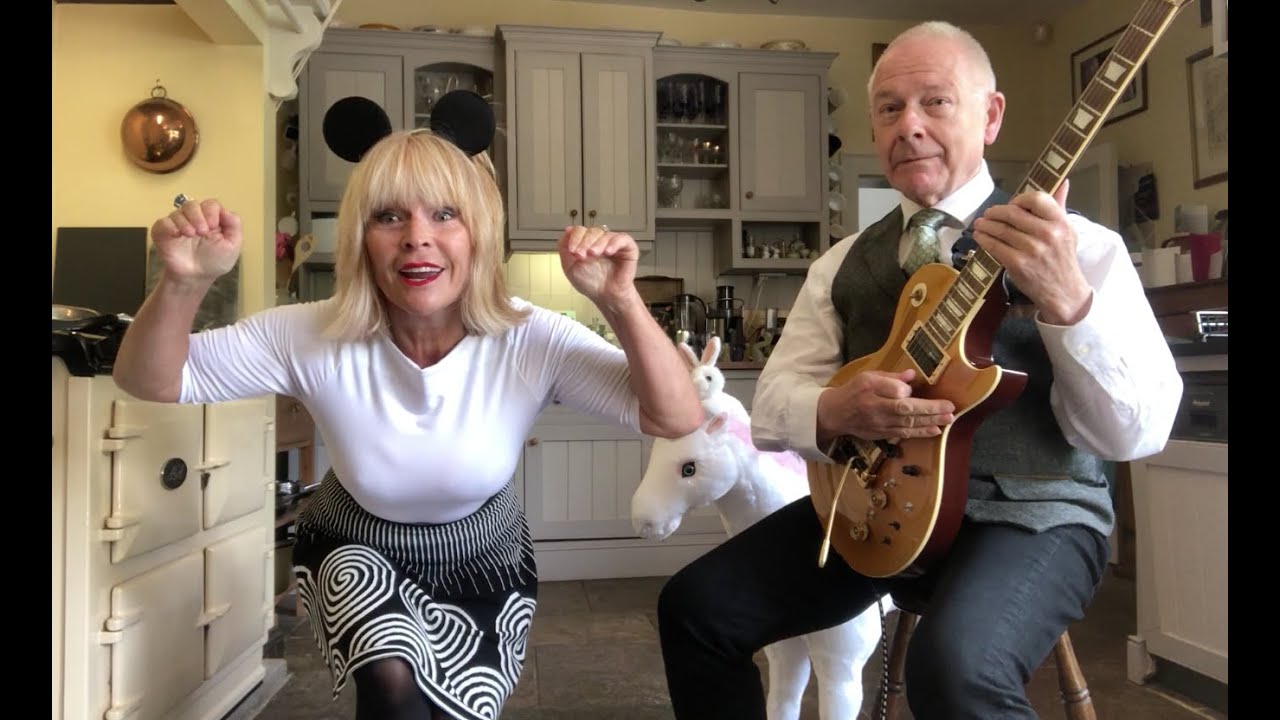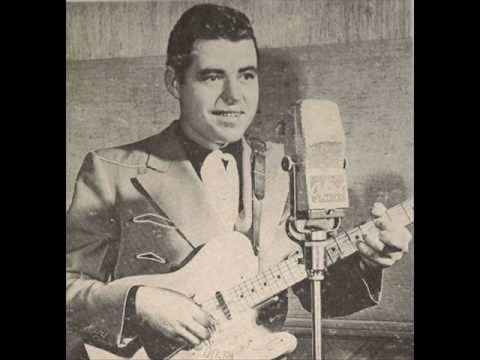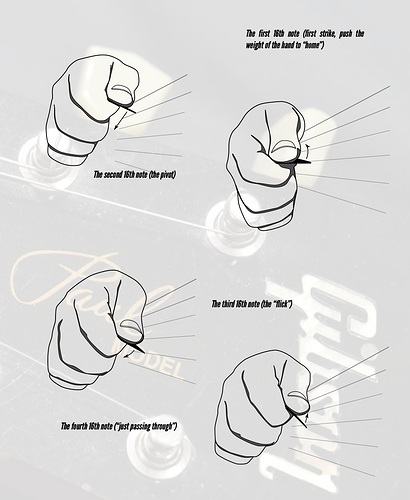I agree that wrist strengthening is probably not the way to go, unless someone has a particular weakness of course. But I do think force becomes more of an issue the less edge-picking there is. We commonly see more elbow deployment from acoustic flat-pickers e.g. World Flat Picking Champs, than with most rock players, and “Gypsy” players do it of course. I don’t think that’s due to just tracking larger distances but that it’s simply much harder work getting “through” the string once you’ve made the aesthetic choice to minimise edge-picking. And it can result in bouncing up into what looks like string hopping; the fact that the pick/hand bounces upwards can be a reaction to the string rather than an active, double wrist extension/flexion in a single pick stroke. Not sure what the latest thinking on/definition of string hopping is though.
On another note- does weight training have any correlation to increasing speed on guitar?
As a muscle gets bigger and more neurologically efficient the capability for endurance increases, as does the capability to move a lower weight faser.
It’s much easier to Bench 135 for reps if you can bench 225 than it is if you can only bench 155. Of course some specialized training is needed in terms of Muscle Fibers for Endurance’s or Strength (Slow Twitch vs Fast Twitch) and for power production (usually done with 50-60% of Max with Bands/Chains while focusing on an explosive Concentric).
Has anyone experimented with weight training (particular the wrist- Extension, Flexion, Radial deviation, Ulnar Deviafion, and Supination/Pronation) and noticed any effect on speed (or ease of a previous strenuous speed)?
Maybe someone could ping John Taylor?
Can’t say for sure if it marginally can have an effect on speed.
What I’m pretty sure is that you DON’T need a lot of strength to perform most of what is playable on the guitar (including acoustic), and iwith lack of further knowledge on the matter there are equal chance (IMHO : more chance) that building strength other than practicing the guitar itself can have unwanted side-effects that hinder your playing more than anything.
I’m generally not inclined to take myself as an example, but I’ll say that: as far as I’m concerned I don’t have a lot of strength in arm/wrist/fingers, probably much less than the average male … I mean I really suck at anything involving throwing with the arm. But I never feel that lack of strength hinder my ability to make progress on the guitar. Btw checking out those young Asian kids shredding on the guitar is enough of an evidence to me that the strength thing is a moot point.
What really is an issue is doing the “wrong” move(s), applying the “wrong” technique(s), that is: doing inefficient moves. But if you do it right, everything MUST feel smooth, so it’s quite the contrary actually, the less strength involved, the better it is. To paraphrase some well known quote “you know it when you feel it”.
Here’s another great shot of Fripp. Playing the moto perpetuo in " FraKctured," the sequel to “Fracture.” CGDAEG New Standard Tuning.
@ 1:40
The “quadfather” Tom Platz might has some insight into this:
Kidding aside this was a cool demonstration between Tom and powerlifting legend Fred Hatfield. Fred, who was older, past his competition prime, and not as massive for his frame, put up a higher single-rep max of over 800 pounds. But when they dropped the weight down to 500 Tom did 23 reps, about twice what Fred put up. There’s some debate over the actual numbers but there seems to be general agreement on the outcome.
Ergo it seems like bodybuilders are really a kind of “power endurance” athlete somewhere between the all-out max of powerlifting and the sustained output of endurance athletes. If you add mass, you’re basically adding the ability to do a high-output activity for longer. Speed skaters and cycling velodrome type racers also have quads consistent with that.
So I don’t know if strength training increases speed as it would matter for guitar playing, but it probably does increase the amount of time you can apply that speed if you’re really talking about all out hyperpicking exertion. If Tom is the quadfather, then @milehighshred is the “fore” [arm] father!
This is pretty great. The turning is still there but it looks less stringhoppy here than in the '70s clip. Can’t tell if that’s just the camera angle or if something has changed in the technique. And of course the endurance is no joke.
Whether or not you like angular prog stuff you cannot deny the commitment to that aesthetic here. This is like the OG instruction manual for “How to Prog” like a boss!
If you type @milehighshred I shall magically appear!
I can’t say for sure that weight training will really lead to a lot of speed gains. Shawn Lane was crazy fast, but I highly doubt he was a weight lifter. He also did admit he had a freak nervous system in one video I saw where he talked about how speed came very naturally for him.
I like to believe that my time in the gym has helped my body improve which, in turn, can help me play better. We all need enough grip strength to play barre chords for extended periods of time, or just learning how to fret. This is why I’ve recommended to some students to get a Varigrip hand trainer to speed up the strength building process for their fret hands.
I like to think that getting more in tune with my body via weight training is one reason I’m able to activate my brachioradialis whenever I want to.
Training your muscles to be stronger can also prevent connective tissue wear and tear. So, even if weight training doesn’t directly make you a better guitar player, it certainly won’t hurt (as long as you train properly).
Hahaha!!!
characters needed for post
I can’t imagine weight training helps with speed. But it looks cool when you’re buff. 
I have a lanky Gilbertesque body… hell… I can hardly lift my guitar… but I can play it pretty fast.
“Angular” is a great descriptor for bands like King Crimson, Gentle Giant, or even The Mars Volta. The first time I heard “Fracture” I immediately noticed two things. Almost no bends and entirely in the whole tone scale which is not something commonly heard in the guitar world.
Bringing this up again, when studying ‘Fracture’ as well as his pre-King Crimson picking piece, ‘Suite No. 1’:
I came across this video which shows him playing the fast part of Fracture, and it might be the best footage available of his fast playing. What I notice is there is a lot of movement for someone so accurate.
I love Fripp but I think it’s also important to be realistic when analysing our guitar heroes. There is quite a lot of audible swiping in this performance - it’s quite obvious if you pay attention to it. So whatever movements he is making are not sufficient to get a consistent string clearance in the required string changes.
This is still a great performance, and in fairness to the great Fripp, these repeating inside-picked patterns can be pretty nasty and a sort of worst-case scenario for some common kinds of alternate picking motions. In the bigger picture he sounds great!
I think you’re making some assumptions about string clearance which may have nothing to do with string clearance. How much clearance does Molly Tuttle get, a few millimeters? All these fast techniques are pretty flat.
As we’ve seen with Steve Morse, there can be swiping on certain phrases but it’s not always because the motion is too flat, it’s because it’s not centered properly on the string. The pickstrokes are still curved but you have to aim them at the right place or you might hit something on the way in or out. And we don’t know, maybe this kind of playing is harder to maintain over the long haul compared to a single escape technique like Gypsy picking. Albert Lee is pretty accurate in almost every clip I’ve seen of him. He’s pretty accurate in our interview too and he was over 60 at that point. So the jury is out.
What is clear is that there are appear to be a few different versions of Fripp’s technique. The first clip at the top of this thread honestly does not look great. Anyone doing that on this forum would immediately be told they were stringhopping and to stop. The motions we see the students doing in the various “League of Crafty Guitarists” clips are also inefficient. Whether or not they’re stringhopping or just using a DBX motion with too great of a V shape I don’t know. But in practice I doubt any of those players could have gone faster with those motions without speed limit and arm tension.
However what he’s doing in the kitchen here looks good. This looks more like elbow-wrist DBX motion. Obviously there are some flubs here, it’s hard to tell with the room echo. But there are definitely parts that sound good too. If there was a time when the accuracy was higher, then I would put this in the Morse category of someone doing a motion that looks fundamentally correct and can be done with accuracy.
Never heard this before but I love the writing style. Much more rootsy than proggy coming from him. Almost sounds like Jimmy Bryant:
Hadn’t heard that Jimmy Bryant tune, either, so I appreciate hearing it…love the style. I also appreciate the analysis of Fripp’s current video, as there just simply isn’t a lot of footage of him available for someone with such a long career.
Robert’s motion is very clearly a lightly supinated DBX wrist motion technique. It’s basically Andy Wood’s motion, just with some elbow. You don’t need the elbow part, you can just use Andy’s motion. Or Molly Tuttle’s motion or Steve Morse’s motion, for that matter. They are all wrist motions, and all generate a flat, side-to-side-appearing motion for whatever your forearm position happens to be:
And this, for more about the wrist joint specifically:
Hi everyone, it’s been a long time since this thread came up and I wasn’t aware of it until now. My name is Anthony and I run Make Weird Music, the youtube channel with the Failure to Fracture video series and book.
Since I’m only limited to posting two links as a new user, I’ve got some relevant gifs that I’ll load up on this page of my website: https://makeweirdmusic.com/articles/fracture-gifs
First, I want to thank Troy for the years of hard work he’s put into picking technique. Amazing stuff. I hope to talk to him someday! Troy’s terminology is quite different from Robert’s, so I didn’t want to go too deeply into both universes and translate between both.
For example, Robert doesn’t do “up” or “down” strokes. He does “release” and “return.” There’s a whole philosophy behind Robert’s picking that is philosophy-first and techique-second whereas Cracking the Code does not incorporate Robert’s philosophy (for good reason). You can learn more about the philosophy here: http://guitarcrafthistory.com/the-guitar-circle-book/the-guitar-circle-by-robert-fripp
Second, I want to share a few GIFs from my research (see the link above)
There’s definitely pick slanting going on, but something I noticed about Robert’s playing is what I call a “flick,” which Troy would probably call an escape technique.
I’ve provided a diagram I drew by tracing Robert’s hand in the aforementioned GIFs. This image comes directly from my Failure to Fracture book.
Since this thread was last updated, I’ve posted my performances of Fracture (YouTube video id: rTIn4cIvtp0) and FraKctured (video id: jRxrFS1663c), which aren’t quite as good as I’d hoped they’d be, but they get the job done.
Hopefully this is of some use for people! Thanks for caring about Robert’s music and technique!
Anthony
Thanks for stopping by! Mechanics nerds unite.
Great graphic. It looks like you’re showing forearm rotation in these snapshots. That’s a common thing you’ll see when wrist players try to do inside picking sequences, where one direction of the motion recruits a little helper motion via the forearm joint (i.e. not wrist).
I’ve seen him do that before in earlier live performances. To be honest it’s always looked awkward, especially the '70s clips. If someone here did that, we’d probably tell them to try playing the line without the “flick”. Firstly, the forearm rotation can cause you to slam into the next note kind of forcefully, and not sound as smooth. And technically if a person is trying to use wrist motion, well, the wrist can make these string changes anyway with no forearm interaction, so why bother? You yourself do it that way, i.e. no forearm, in the clips above in this thread.
Interestingly, in the recent “kitchen” performance of Fracture, I don’t see any forearm motion. Or if it’s there, it’s minimal. It just looks like elbow motion plus wrist motion, but nothing rotational. You don’t really see that kind of technique change too often in “famous” players once things solidify, so I wonder if he made an effort to get rid of it.
Most of Fracture’s picking is between two strings with a lot of inside picking, but in the original release (which Robert no longer plays), there’s a section I called “Death Picking” because it is constant string skipping with inside and outside picking. It’s extremely complex and Robert plays it with deadly accuracy. He actually took that entire picking sequence with the left hand fingering and translated it into a new piece called The Moving Force, which you can see here:
This is a formidable piece and Robert plays it with such ease and finesse. It’s quite aggravating, if you ask me! haha
Thanks for your kindness and generosity, Troy.
Ah yes, that guy… Go Toyah! 
*uh, to be clear, I am a huge Crimson fan.





